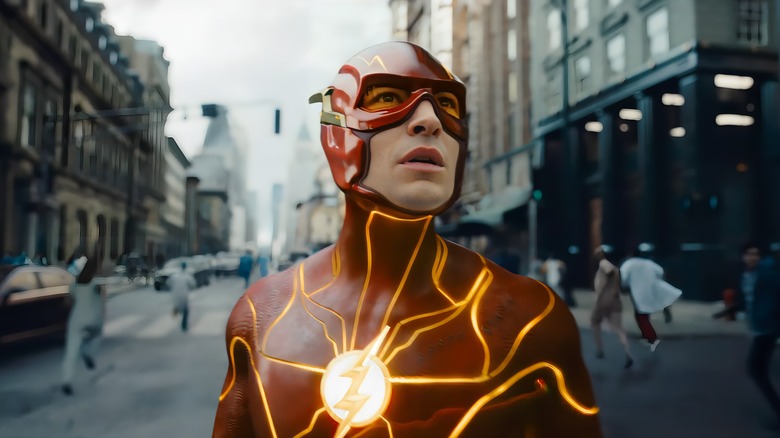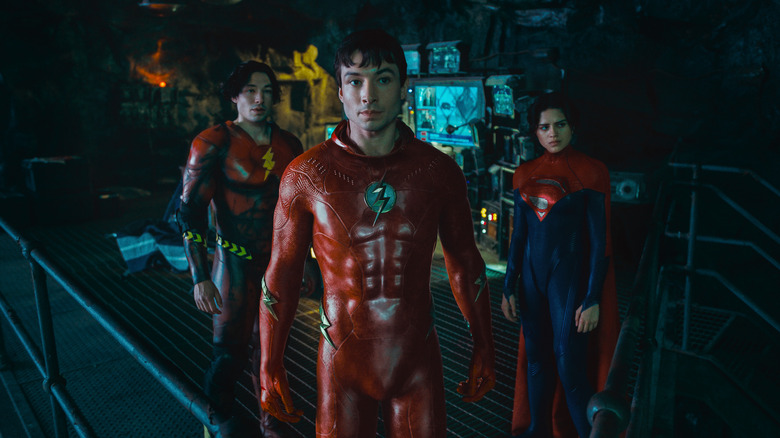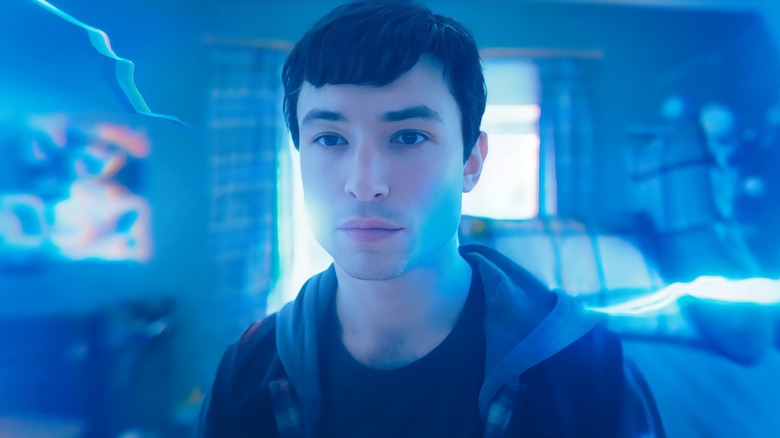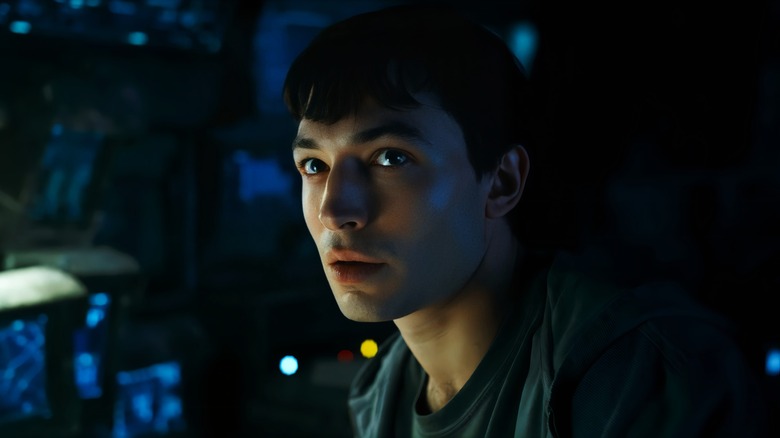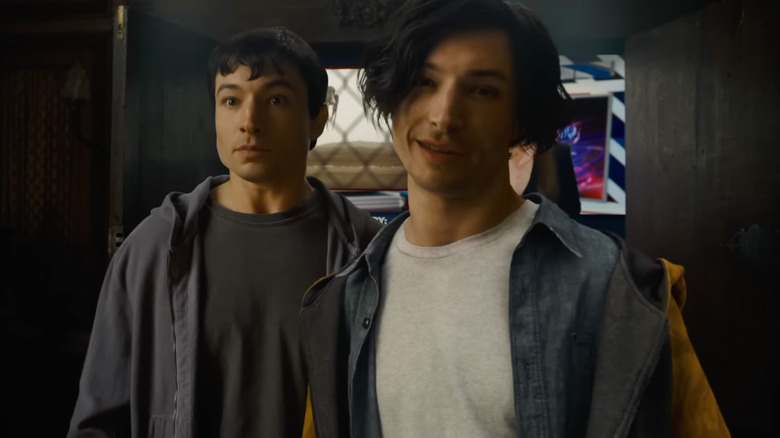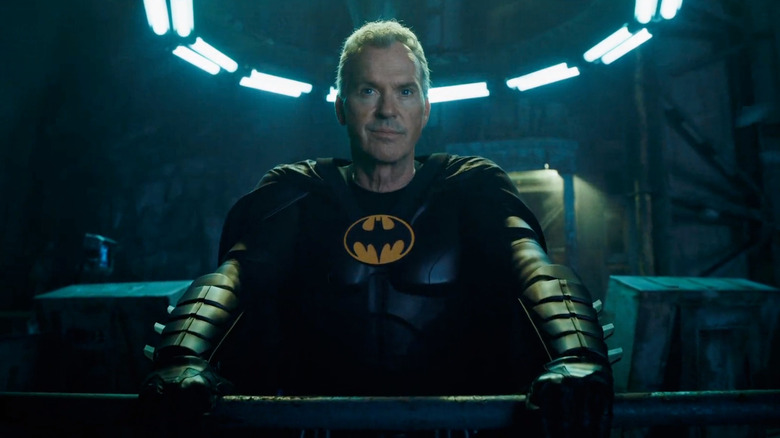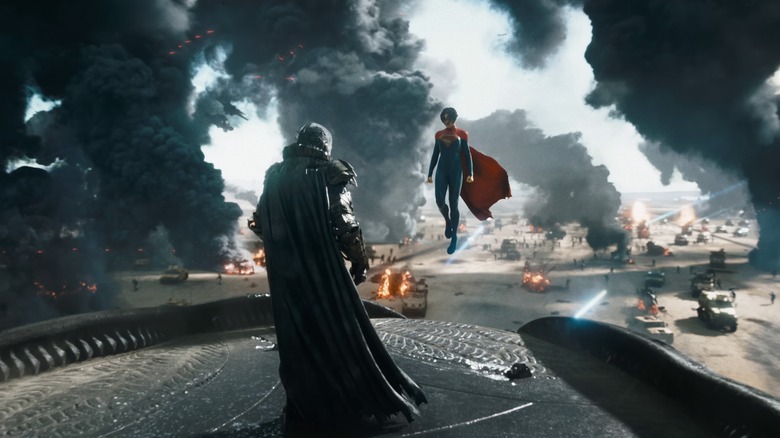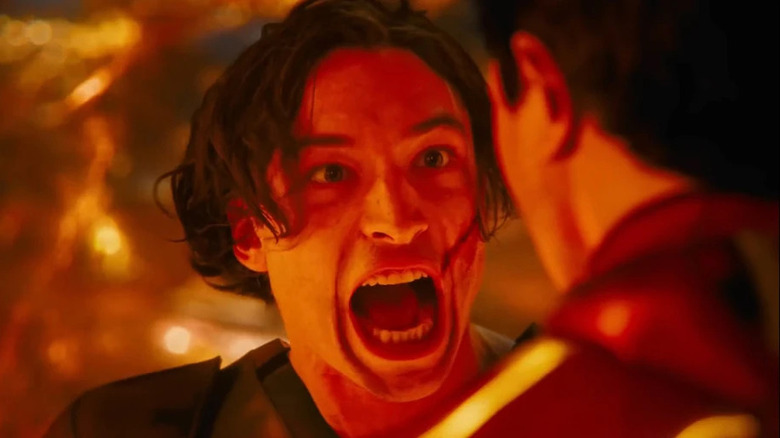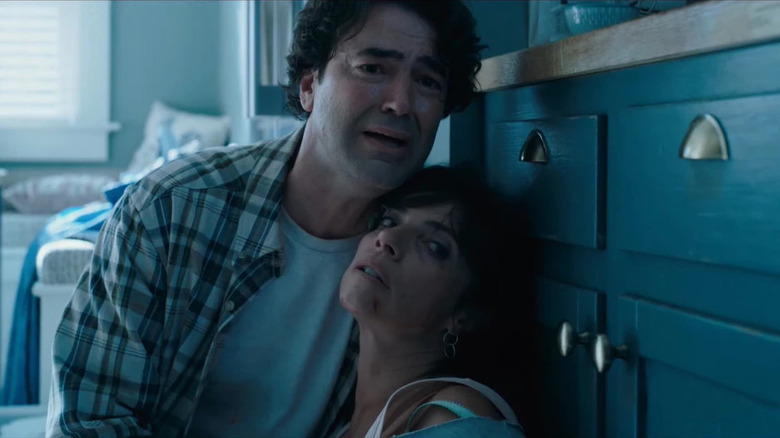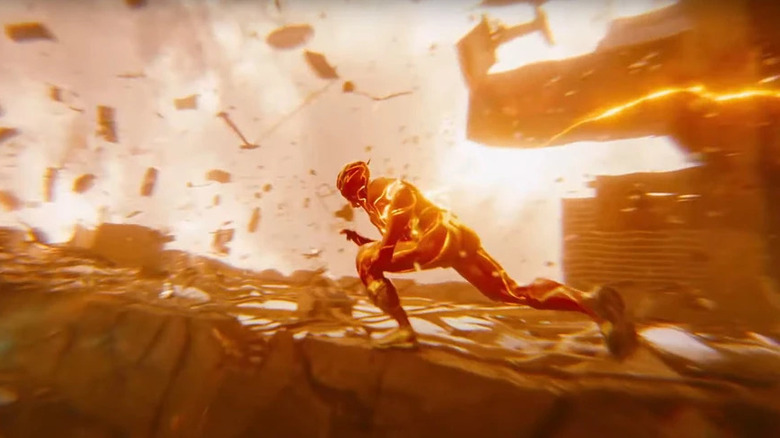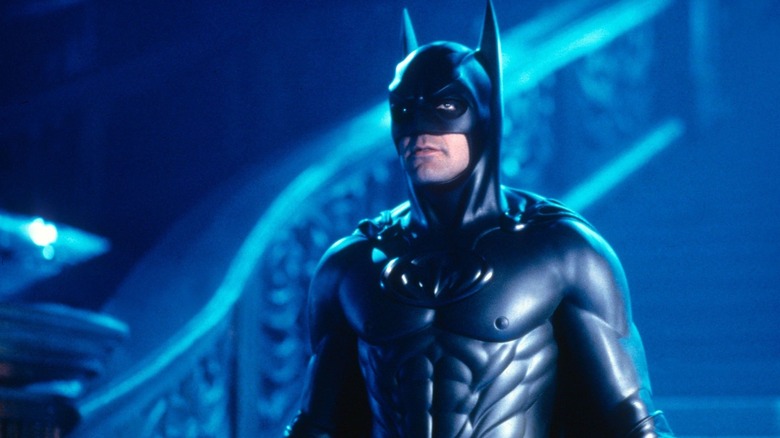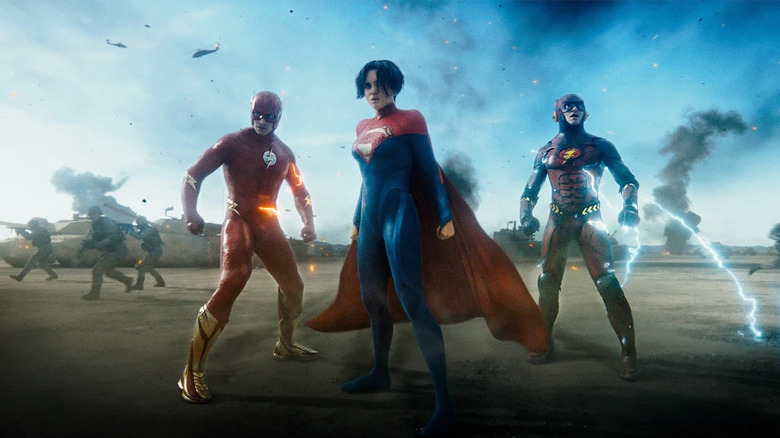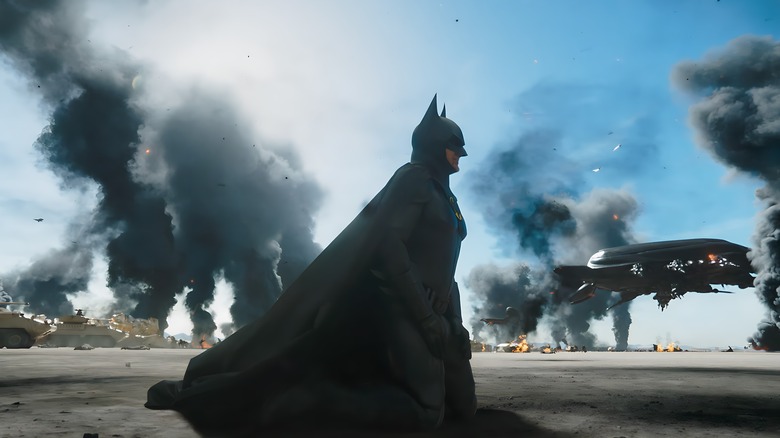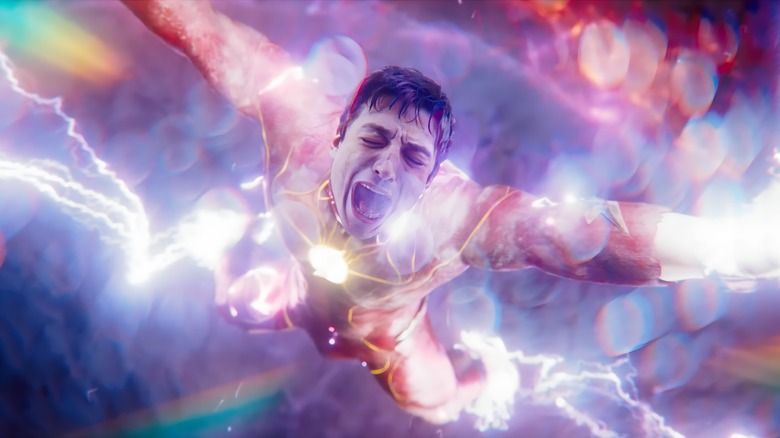The Ending Of The Flash Explained
Contains spoilers for "The Flash"
"The Flash" emerged as one of the most anticipated superhero films of 2023 for two key reasons. First, it's a film that was in the works for a very long time, more than a decade, before director Andy Muschietti and writer Christina Hodson finally brought the finished version to audiences. Second, it's the film that's supposed to open up the DC Multiverse in ways that might prove very important for the entire future of DC Comics on the big screen. So there's a lot riding on this movie.
Because of that, "The Flash" is jam-packed with plot, cameos, and other emotional and narrative nods that both raise the stakes for the film itself and help to pave the way for what might come next. There's a lot to go over, and the closer you get to the ending, the more complex it all gets. So we're here to break it all down. This is the ending of "The Flash," explained.
What you need to remember about the plot of The Flash
"The Flash" is an elaborate, dimension-hopping adventure that all stems from one choice: Barry Allen's (Ezra Miller) decision to run back in time, stop his mother's (Maribel Verdú) murder, and save her life. The trouble is that Barry's choice sets off a chain reaction that brings him back to an entirely different present, one in which a younger version of himself (also Ezra Miller) has not yet become the Flash, Superman never made it to Earth, and Zod (Michael Shannon) is about to attack the planet.
To save the world, Barry has no choice but team up with his younger self; an aging, alternate-reality Batman (Michael Keaton); and a Kryptonian warrior named Kara Zor-El (Sasha Calle), all while he must face a crucial truth: Eventually, he has to go back and let his mother die, or the world will never be the same again.
This all culminates in a multifaceted showdown that pits Barry and his friends against Zod, Barry against his own alternate self, and Barry against his own emotions, and the choices he makes literally have reality-altering consequences not just for himself, but for everyone. So let's dig deeper into those choices, their repercussions, and their meaning.
Barry Allen's journey
When we meet the prime version of Barry Allen in "The Flash," he's been a superhero for a while, and it's clear that he has some standing in the wider superhero community. He's a member of the Justice League, an ally of Batman (Ben Affleck), and a guy who's got more than a few fans out on the street. He's also, it turns out, still fixated on one key thing in his life.
For years, Barry has worked hard to find the one piece of evidence that will get his father (Ron Livingston) out of jail. It's been years since he was wrongfully arrested for the murder of his wife, and Barry's life as a crime lab scientist is almost entirely informed by his quest to exonerate his dad. The problem is that, for one reason or another, it's not working. No piece of evidence ever breaks his way enough to get his father out of jail, including surveillance video that would have put him at another location when Barry's mother was murdered.
When that video doesn't prove to have enough evidence, Barry sprints out in a rage and accidentally discovers a way to roll back time and change the past. His plan then comes together very quickly, which helps explain why it has so many unintended consequences and how hard it is for him to make the choice he must in the end.
What happens to the Prime Barry Allen?
By the end of the film, as Zod's battle rages around him, Barry comes to a very difficult conclusion: He can't alter the future. It's a lesson he learns when, in the midst of turning back time to try and save both Supergirl and Batman from death in battle, he realizes that they die in pretty much every scenario. That version of Earth is doomed, and it's all because Barry went back and tried to fix things to begin with. It's a lesson underlined by what happens to his alternate Barry, who goes back to try and save things so many times that he transforms into something utterly monstrous, something completely removed from who he originally was.
Full of heartache, Barry makes the hardest possible choice. He goes back in time again and changes reality back to the one in which his mother is murdered and his father is imprisoned. It's an important decision in his larger journey as a hero, particularly since he spends the beginning of the film bemoaning his place as the Justice League's resident "janitor," and it proves his maturity when it comes to understanding the greater good. But it's also an important emotional moment, in which Barry realizes what both versions of Batman tried to teach him: Our scars, our tragedies, make us who we are, whether we like it or not.
What happens to alternate Barry Allen?
Barry's alternate self comes into "The Flash" several years younger than his Prime universe counterpart, and it shows. He's not just more immature than the Barry we've come to know, but he hasn't gotten superpowers yet, and when he finally does get them, he doesn't exactly prove right away that he knows the best way to use them. It's for these reasons that Barry doesn't tell his younger self the reason why he came back in time to begin with — that is, until, the alternate-reality Barry overhears him.
This information changes everything for the younger Barry. While the Prime Barry spends the film coming to the realization that he has to let go of the past in order to save the future, the alternate Barry thinks that if he just tries enough times, he can stop tragic events from happening. As a result, he runs himself right into becoming a supervillain, altering reality so many times that he risks destroying an entire multiverse of worlds that collide in the film's climax. But as he meets his death at his own future self's hands, we do get some closure for this version of Barry. His last act, after endless selfish attempts to control the world and the course of events, is to sacrifice himself to save Prime Barry. In that way, despite everything, he manages to go out as a hero.
What happens to Batman?
When we meet the alternate universe's version of Batman, we find him with his crimefighting career already over, living alone in a dusty, rundown version of Wayne Manor, with nothing to do all day but drink and grow his beard. Eventually, he explains that it turned out this way because he did his job a little too well. Gotham City is no longer crime-ridden, they don't need Batman, and as a result, Bruce Wayne is a lost man, someone with no real sense of purpose now that his singular mission is seemingly complete.
Meeting the two Barrys, and eventually Supergirl, helps Batman see a new path forward for himself, so much so that he eagerly shaves, straps the suit back on, and goes into battle alongside his new friends. It's a fight he clearly relishes, in part because he's never had the opportunity to fight alongside metahumans before, but mostly because he has a purpose again and it feels good to get back out there.
Eventually, as the climactic battle rages and the Barrys' time-traveling proves useless in changing the outcome, it's clear that Batman is meant to die trying to save Earth from General Zod. It's tragic, but not for Bruce Wayne himself. For him, it's a good way to go out — doing something to help others, fighting evil for as long as he can, as hard as he can. It proves the kind of hero he is, the kind of hero he always was.
What happens to Supergirl?
By the time we meet Kara Zor-El aka Supergirl in "The Flash," she'd been locked up and drained of her energy for years. She's furious at humanity — so when Barry comes knocking, she asks, why should fight for these people, even as Zod approaches?
Kara's mind changes thanks to the kindness and persistence of her new friends and rescuers — both Barrys and Batman — and she starts to grasp what the stakes of the conflict are when she realizes Zod's true intentions. In this universe, she's the Kryptonian refugee who contains the genetic key to the future of her species, while her cousin, Kal-El, was apparently a spare who died when he was a baby. When Zod hints that he might have been the one who killed the child, Kara flies into a rage, ready to battle to her last breath. Unfortunately for her, this is the universe where Zod wins, which means that no matter how hard she fights, she ends up dead at Zod's hands.
Sadly for Kara, that's the end of her character arc for this film, but her presence in the film and the hard lessons taught by her story drive Barry to go back in time and restore his own past. Plus, now that we've established a multiverse within DC, it feels like Kara could re-emerge, with a more hopeful narrative, very soon.
Who's that dark and mysterious villain?
Throughout "The Flash," the Prime Barry Allen is subjected to occasional visits from a dark, vicious being in black who seems to have all of his speed, but none of his impulse to do good. The villain's overall look, and his status as a fellow speedster, all suggest the arrival of Savitar, a DC Comics villain who, in The Flash TV series, appeared as an alternate Barry Allen.
At the end of the film, this Savitar-like monster does indeed appear as another version of alternate Barry, specifically another version of Barry's alternate ally, who's spend years running through the multiverse trying to reverse time, fix the final battle, and defeat Zod. In the process, he's had Kryptonian metal embedded in his body time and time again, turning him into a scarred monster who's in constant pain but still convinced that he can fix everything if he just keeps running.
This version of Barry is ultimately killed when his own past self, the alternate Barry, sacrifices his live to save Prime Barry. That means his presence is, eventually, onlya cautionary tale for Prime Barry, who realizes at the end that he has no other choice but to embrace his own past, pain and all. Savitar doesn't exist for long in the course of this movie, but his actions and his monstrous appearance teach a very important lesson.
What happens to Barry's family?
At the end of "The Flash," Barry Allen embraces the pain of his past and decides the only way to save the present is to go back in time and make sure his mother does indeed end up murdered. But that doesn't mean he doesn't change anything. While dooming his mother, Barry still finds a way to save his father. Barry minutely alters the placement of a can in the grocery store so that his dad has to look up and the store's surveillance camera could see his face clearly, giving him the exonerating evidence necessary to get out of jail.
This means that, back in Barry's present, his father finally goes free after years behind bars, giving father and son a new family dynamic after a very long time apart. What's key, of course, is that Barry's father doesn't actually know that his son is the Flash, or that he managed to engineer his release beyond just working at a crime lab in his present-day life. It'll be interesting to see if future films ever give us a glimpse of how that father-son vibe changes.
What Barry Allen's ending means
The last time we see Prime Barry in the main narrative of "The Flash," he's just managed to produce evidence that will exonerate his father, freeing the one parent he has left and basically giving him a sense of family that he's spent years living without. But not everything wraps up so neatly — there are a few dangling threads at the end of the film.
For one thing, there's Iris West (Kiersey Clemons), Barry's old friend who seems to have taken a liking to him. In the comics, they end up as a couple, and Iris' nephew, Wally West, becomes a new Flash further down the line. Is that romance budding? Only time will tell — if another "Flash" film is on the horizon, that is.
Then, of course, there's the matter of Bruce Wayne. As Barry leaves the Central City courthouse, he's greeted by Bruce's car, but it's not the Bruce he knows. In his place is yet another Batman, suggesting that something in the multiverse has still been broken by Barry's rescuing of his father. So does he go back and change that or leave things the way they are? The film doesn't answer this definitively, but it proves multiversal tinkering has only just begun in the DCU going forward.
What those two big cameos mean
Over the course of its runtime, "The Flash" deploys two very big cameos that are worth breaking down. At the very end of the film, Barry learns that his universe has a new Bruce Wayne in the form of a guy who looks just like George Clooney, who previously played the Caped Crusader in 1997's "Batman & Robin." Though it's gotten something of a reappraisal in recent years, that film has often been trashed for its campy tone, to the point that Clooney himself has jokingly apologized for making the movie. By throwing him into this film at the last minute, "The Flash" gives Clooney a small measure of redemption, while also throwing the audience a big laugh.
Then there's that cameo in the multiverse sequence, during which we also see Superman played by George Reeves and Christopher Reeve. In that sequence, we see one Superman fighting a giant, alien spider creature, sporting long hair and a grim, determined look. It's then revealed that this Superman looks exactly like Nicolas Cage. It's all an elaborate nod to "Superman Lives," an abandoned Superman project from the 1990s in which Cage would have played the character for director Tim Burton. The spider creature in particular is a legendary abandoned concept from that film, and "The Flash" tells us that somewhere out in the multiverse, Cage got to be the Man of Steel after all.
What the ending means for the multiverse
Near the end of "The Flash," we get a very up-close look at the DC Multiverse as worlds start to collide in the wake of alternate Barry's constant meddling with time. Over the course of this sequence, we glimpse several different Earths, all with their own metahumans fighting various battles, including the Jay Garrick incarnation of the Flash from the Golden Age of comics. Just as Batman warned earlier in the film, Barry's insistence on creating more and more inflection points has led to a tangle of alternate worlds, all of them now in danger.
What we know, based on the film's ending, is that Prime Barry's decision to go back and fix his original timeline, sacrificing his mother in the process, brought some stability to the universe again. What we don't know just yet is what those actions mean for the wider multiverse. Do those worlds still exist? And if so, are they at all aware of each other? Is the upcoming DC Universe also a part of that multiverse? These are lingering questions, but what's clear is that "The Flash" was DC's chance to introduce a reality in which multiple versions of the same hero can coexist and thrive, albeit on their respective versions of Earth. It's much like the way DC Comics worked for decades, and the way "The Flash" sets up the DC multiverse creates an interesting jumping-off point.
What happens in the post-credits scene?
After the main narrative is over, "The Flash" shows us a brief post-credits scene in which Barry and Arthur Curry aka Aquaman (Jason Momoa) come stumbling out of a bar. Barry's been chatting with Arthur about what he just experienced, recounting specifically the idea that there are different Batmen in different universes, all while Arthur might be just a little too drunk to keep track of it all. It's a fun little scene, but what it doesn't tell us is exactly what's happening to this universe in the time since the film's ending proper.
Is the Bruce Wayne of Prime Barry's world just a guy who looks like George Clooney now, or did he go back and find a way to restore the Ben Affleck version to the timeline? If so, does that mean Barry's father is back in jail? The film has proven to us time and time again that every action in the past has a reaction in the future, so what does this mean? It's not clear, but Barry does refer to all those alternate Batmen in the past tense, so maybe it's all changed after all. We'll have to wait for more DC adventures to know for sure.
Where do we go from here?
In the months leading up to the release of "The Flash," fans became aware of some major changes at work over at DC Studios, where James Gunn and Peter Safran have taken over as masterminds of the future of the DC Universe on the big screen. Gunn has been pretty clear that he intends to produce many new stories from scratch, including casting a new Superman. What we still don't know is how this will affect characters like the Flash, Wonder Woman, Aquaman, Shazam, and more established DC heavy-hitters.
It's pretty clear from the way "The Flash" ends that, if they so chose, Gunn and Safran could keep right on telling stories with these characters in a few ways. They could simply say that the Earth that Barry went back to when he released his father from jail — the present — is now a different world with different versions of certain heroes, like George Clooney as Batman. Or they could start from scratch and pick and choose which actors to bring back, playing different versions of the same characters. However it works out, "The Flash" was clearly built as the film that would create multiple avenues for these stories, and that means the future is wide open.
